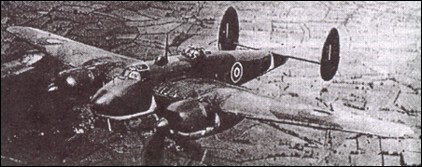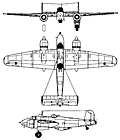 |
Bristol 163 Buckingham1943 |  |
| BOMBER | Virtual Aircraft Museum / United Kingdom / Bristol |
 |
When design of a Bristol Blenheim replacement was begun, the Bristol team had no means of knowing that their new tactical day bomber, the Type 163 Buckingham, was to be rendered obsolete before it had flown by the superlative performance of a private venture wooden bomber. This was the de Havilland Mosquito, which could carry the same 1814kg bomb-load at a speed of 80km/h faster with a crew of two instead of four, although admittedly for a lesser distance. Bristol's earlier project to Specification B.2/41, the Type 162, itself replacing a previous Bristol Beaufighter bomber scheme, the Type 161 Beaumont, was revised as a result of official delays in finalising requirements. It was further delayed by teething troubles with the new Bristol Centaurus engines, and it was not until 4 February 1943 that the prototype Buckingham flew, without armament. The second, armed, prototype followed shortly afterwards and was followed by two more, all with Centaurus IV engines with high-altitude rating, although production aircraft were to have medium-altitude Centaurus VIIs or XIs. Minor control modifications were made before the first production Buckingham flew on 12 February 1944, but changes were made to the tail surfaces after 10 had been completed to improve stability, particularly in single-engine performance. Although outclassed by the Mosquito in European operations, it was felt that the Buckingham's superior range would prove a great asset against the Japanese. But by the time production aircraft were being delivered the end of the Far East war was in sight and the original order was cut from 400 to 119, plus the four prototypes. With the end of their potential usefulness as bombers, it was decided to convert the Buckinghams to fast courier transports; the last batch of 65 on the line were completed as Buckingham C. Mk 1 transports and it was intended that the earlier Buckingham B. Mk 1 bombers would be retrospectively modified to the same standard. In this configuration (with extra tankage, seats for four passengers and a crew of three) the Buckingham had a range of 4828km and was used on services to Malta and Egypt, although they were uneconomical with such a small passenger capacity. Two were adapted to accommodate seven passengers, but the modification proved too expensive and was not taken further. Although the 54 bomber versions were returned to Filton for conversion, most were stored and eventually scrapped with very low hours, the last surviving Buckingham being used as a ground testing rig until 1950. FACTS AND FIGURES © The Buckingham exhibited poor stability until the tail surfaces were all enlarged. Many other modifications were needed to make it acceptable for service. © As a transport the Buckingham C. Mk 1 had superior range to the Mosquito, but with a capacity of only four passengers, it was not very economical and saw little use. © Instead of putting the bomb-aimer in a glazed nose, the Buckingham had him in a drag-inducing mid-fuselage gondola.
|  COMPANY PROFILE | |||||||||||||||||||||||||||||||||||||||||||||||||||||||||||||||
 |

|

